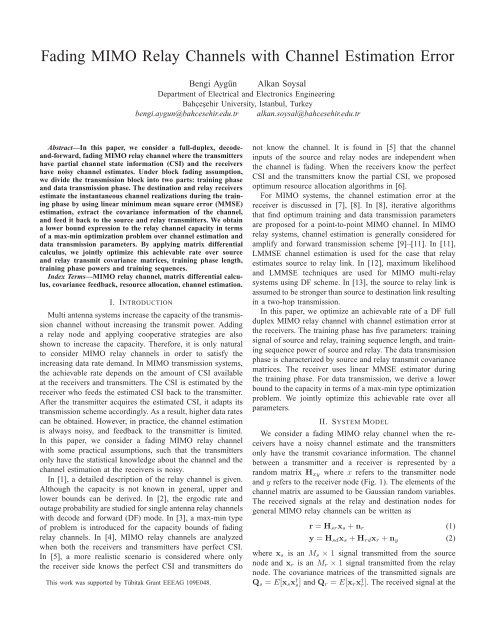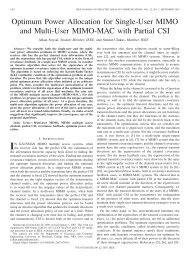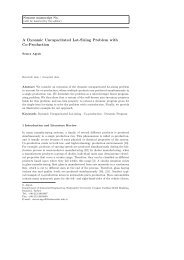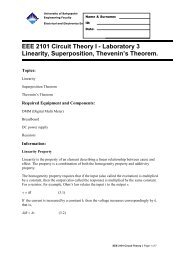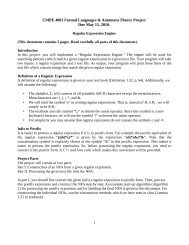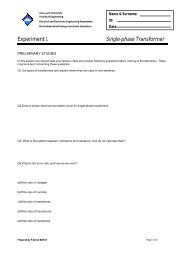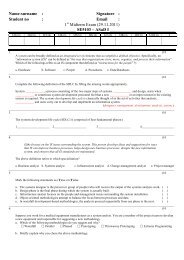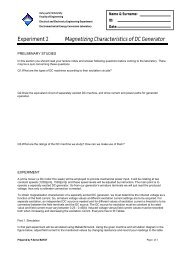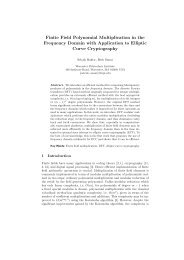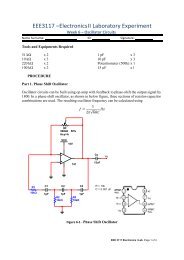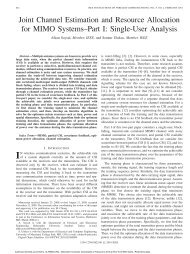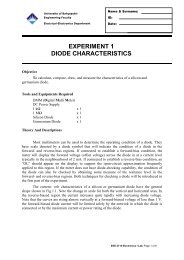Fading MIMO Relay Channels with Channel Estimation Error
Fading MIMO Relay Channels with Channel Estimation Error
Fading MIMO Relay Channels with Channel Estimation Error
You also want an ePaper? Increase the reach of your titles
YUMPU automatically turns print PDFs into web optimized ePapers that Google loves.
user problem, here we only provide optimization of I sr . TheLagrangian of the optimization problem is written asL = I sr (S)−µ s (tr(Q s )T d + tr(SS † )−P ds T d ) (22)where µ s is the Lagrangian multiplier. Using matrix differentialcalculus, we take the derivative of the Lagrangian<strong>with</strong> respect to Q s and obtain Karush-Kuhn-Tucker (KKT)conditions corresponding to Q s as[T d 1T E M K− 1 ]M 2 tr(KQ s) ˜Σ sr ≤ µ s IT d (23)where D sr is)the inside of the determinant in (18), M =1+tr(Q s˜Σsr and K = Ĥ† srD −1sr Ĥsr. The KKT conditionsin (23) are satisfied <strong>with</strong> equalities whenQ s is positive definiteand <strong>with</strong> strict inequalities when Q s is a zero matrix. In orderto solve for Q s , we need equalities for all values of Q s .Therefore, we utilize the reasoning that is first introduced in[16]. Let us denote the expectation expression at the left handside of (23) as E 1 . We multiplying both sides of (23) <strong>with</strong> Q sin order to obtain equalities when Q s equal to zero as well.Next, we apply the trace operator to both sides to get1T tr(E 1Q s ) = µ s tr(Q s ). (24)Since the optimization is over training signals as well, we needto find a similar equation involving S s . Taking the differentialof the Lagrangian <strong>with</strong> respect to the training signal, S s , weobtaindL = T dT E[ tr ( D −1sr dD sr)]−2µs tr ( d(S s )S † )s (25)In order to find dD sr , we use the partial differential rule [15,pg167] to get the KKT conditions corresponding to S sT dT E [ 1M 2 tr (Ĥ† sr D −1sr ĤsrQ s)˜Σsr Q s˜Σsr S s]≤ µ s S s (26)Similar to the previous derivation, we define the left side of(26) as E 2 , multiply both sides of the expression <strong>with</strong> S † s andapply the trace operator to getT dT tr(E 2S † s) = µ s tr(S s S † s) (27)Due to conservation of energy, we know that P ds T d =tr(Q s )T d + tr(S s S † s ). When we multiply (24) <strong>with</strong> T d, andthen add to (27), we haveT dT tr(E 1Q s )+ T dT tr(E 2S † s ) = µ sP ds T d (28)We pull the Lagrangian multiplier from (28) and plug it into(23) and (26) and finally obtain training signal and transmitcovariance matrices asQ s = 1 E 1 Q sT d tr(E 1 Q s )+tr(E 2 S † s) P ds (29)E 2S s =tr(E 1 Q s )+tr(E 2 S † s) P dsT d (30)Using these fixed point equations, we propose the followingiterative algorithmsQ s (n+1) = 1 E 1 (n)Q s (n)T d tr(E 1 (n)Q s (n))+tr(E 2 (n)S † s(n)) P ds (31)E 2 (n)S s (n+1) =tr(E 1 (n)Q s (n))+tr(E 2 (n)S † s(n) P dsT d (32)Next, we find the relay transmit covariance matrix, Q r , andrelay training signal,S r , by optimizingI mac (S) <strong>with</strong> fixedQ sand S s . This is equivalent to the single user problem which issolved above and omitted here due to space restrictions.Case 2: In the second case, (α = 1), R(1,S) = I mac (S)and the conditionI mac (S) ≤I sr (S) should be satisfied. In thiscase, the achievable rate is found by maximizing (19), whichis a MAC problem. The conservation of the energy providesP ds Td = tr(Q s )T d + tr(S s S † s) and P dr Td = tr(Q r )T d +tr(S r S † r ). Since most steps in Case 2 are similar to Case 1,we will not provide all the details in the following derivation.By taking the derivative of the Lagrangian, we obtain KKTconditions corresponding to Q s and Q r as[T d 1T E W A− 1 ]W 2 tr(AQ s) ˜Σ sd ≤ µ s IT d (33)[T d 1T E W B− 1 ]W 2 tr(BQ r) ˜Σ rd ≤ µ r IT d (34)where D mac is the inside of the determinant of (19),A = Ĥ† sd D−1 macĤsd, B = Ĥ† rd D−1 macĤrd, and W = 1 +tr(Q s˜Σsd )+tr(Q r˜Σrd ). We define the expectation at the lefthand side of (33) as E 3 and the expectation at left hand sideof (34) as E 4 . In order to obtain equalities for all Q s and Q r ,we multiply the both sides of (33) <strong>with</strong> Q s and both sides of(34) <strong>with</strong> Q r . Finally, we apply trace operator to get1T tr(E 3Q s ) = µ s tr(Q s ) (35)1T tr(E 4Q r ) = µ r tr(Q r ) (36)Now, we calculate KKT conditions corresponding to thetraining signals. By using matrix differential calculus, we cantake the derivative of (19) <strong>with</strong> respect to S s and S r to obtainthe following KKT conditions[ ]T d 1T E W 2 tr(AQ s) ˜Σ sd Q s˜Σsd S s ≤ µ s S s (37)[ ]T d 1T E W 2 tr(BQ r) ˜Σ rd Q r˜Σrd S r ≤ µ r S r (38)We define the expectations at the left hand sides of (37) and(38) as E 5 and E 6 respectively. To obtain equalities for all S sand S r , we multiply both sides of the expressions above <strong>with</strong>S † s and S† r respectively. Finally, we apply the trace operatorto getT dT tr(E 5S † s) = µ s tr(S s S † s) (39)T dT tr(E 6S † r ) = µ rtr(S r S † r ) (40)Using the conservation of energy, we obtain the Lagrange
multipliers and from there we obtain fixed point equations.Using these equations, we propose the following iterativealgorithms as in the previous case.Q s (n+1) = 1 E 3 (n)Q s (n)T d tr(E 3 (n)Q s (n))+tr(E 5 (n)S † s(n)) P ds (41)Q r (n+1) = 1 E 4 (n)Q r (n)T d tr(E 4 (n)Q r (n))+tr(E 6 (n)S † r(n)) P dr (42)E 5 (n)S s (n+1) =tr(E 3 (n)A † (n))+tr(E 5 (n)S † s(n)) P dsT d (43)S r (n+1) =E 6 (n)tr(E 4 (n)B † (n))+tr(E 6 (n)S † r(n)) P drT d (44)Case 3: In the third case, (0 < α < 1), R(α,Q) =I mac (Q) + (1 − α)I sr (Q) and the condition I mac (Q) =I sr (Q) should be satisfied. Due to space constraint, we skipthe details of this derivation. One can follow similar steps toCase 1 and Case 2 in order to obtain the following algorithmQ s (n+1) = 1 αE 3 (n)Q s (n)+(1−α)E 1 (n)Q s (n)P ds (45)T d XQ r (n+1) = 1 (1−α)E 4 (n)Q r (n)P dr (46)T d YS s (n+1) = αE 5(n)+(1−α)E 2 (n)P ds T d (47)XS r (n+1) = (1−α)E 6(n)P dr T d (48)Ywhere X = tr(αE 3 (n)Q s (n) + (1 − α)E 1 (n)Q s (n)) +tr(αE 5 (n)S † s(n) + (1 − α)E 2 (n)S † s(n)) and Y = (1 −α)tr(E 4 (n)Q r (n))+(1−α)tr(E 6 (n)S † r (n)).VI. NUMERICAL RESULTSIn this section, we simulate our iterative algorithms. InFig. 2, we considered a system where all nodes have threeantennas. We found the lower bound for three different channelcovariance examples. For the channel covariance matrix thatresult in Case 1, the capacity expression is equal to I sr . Forthis channel parameters, the lower bound is 2.9 bit/sec. For thechannel covariance matrix that result in Case 2, the capacityexpression is equal to I mac . For this channel conditions, thelower bound is 2.58 bit/sec. For the channel covariance matrixthat result in Case 3, the lower bound on the capacity is thevalue at the point α = 0.2. The lower bound value is 2.7bit/sec. More detailed numerical analysis will be provided inthe extended journal version of this work.VII. CONCLUSIONWe analyzed achievable rates under noisy channel estimationin a full-duplex DF <strong>MIMO</strong> relay channel, where thetransmitters have covariance information of the channel. Byutilizing matrix differential calculus, the joint optimizationproblem is solved over training signals, training duration,training power and transmit covariance matrices of the sourceand relay nodes. It is important to note that the proposediterative algorithms solve for all matrices directly <strong>with</strong>out firstdecomposing into their eigenvalues and eigenvectors.V(α)54.543.53α*=1α*=0α*=0.22.50 0.2 0.4 0.6 0.8 1αFig. 2. Capacity lower bounds that result in three different cases, i.e.,α ∗ = 0for the solid, α ∗ = 1 for the dotted, and α ∗ = 0.2 for the dashed line.REFERENCES[1] T.M. Cover and A.A. El Gamal. Capacity theorems for relay channel.IEEE Transactions on Information Theory, 25(5):572–584, September1979.[2] A. Host-Madsen and J. Zhang. Capacity bounds and power allocationsfor wireless relay channels. IEEE Transactions on Information Theory,51(6):2020–2040, June 2005.[3] Y. Liang, V.V. Veeravalli, and H.V. Poor. Resource allocation forwireless fading relay channels: max-min solution. IEEE Transactionson Information Theory, 53(10):3432–3453, October 2007.[4] G. Kramer, M. Gastpar, and P. Gupta. Information-theoretic multihoppingfor relay networks. In International Zurich Seminar onCommunication, February 2004.[5] B. Wang, J. Zhang, and A. Host-Madsen. On the capacity of <strong>MIMO</strong>relay channels. IEEE Transactions on Information Theory, 51(1):29–43,January 2005.[6] B. Aygün and A. Soysal. <strong>Fading</strong> mimo relay channels <strong>with</strong> covariancefeedback. In WCNC, 2012.[7] T. Yoo and A. Goldsmith. Capacity and power allocation for fading<strong>MIMO</strong> channels <strong>with</strong> channel estimation error. IEEE Transactions onInformation Theory, 52(5):2203–2214, May 2006.[8] A. Soysal and S. Ulukus. Joint channel estimation and resource allocationfor <strong>MIMO</strong> systems–Part I: Single-user analysis. IEEE Transactionson Wireless Communications, 9(2):624–631, February 2010.[9] F. Gao and A. Nallanathan. On channel estimation and optimal trainingdesign for amplify and forward relay networks. IEEE Transactions onWireless Communications, 7(5):1907–1916, 2008.[10] B. Jiang, F. Gao, X. Gao, and A. Nallanathan. <strong>Channel</strong> estimation andtraining design for two-way relay networks <strong>with</strong> power allocation. IEEETransactions on Wireless Communications, 9(6):2022–2032, 2010.[11] A.S. Behbahani and A. Eltawil. On channel estimation and capacity foramplify and forward relay networks. In Globecom, 2008.[12] F. Gao, T. Cui, and A. Nallanathan. Optimum training design for channelestimation in decode-and-forward relay networks <strong>with</strong> individual andtotal power constraints. IEEE Transactions on Signal Processing,56(12):5937–5949, 2008.[13] Z. Chen, H. Liu, and W. Wang. Optimal transmit strategy of a twohopdecode-and-forward mimo relay system <strong>with</strong> mean and covariancefeedback. IEEE Communication Letters, 14(6):530–532, 2010.[14] C. Chuah, D. N. C. Tse, J. M. Kahn, and R. A. Valenzuela. Capacityscaling in <strong>MIMO</strong> wireless systems under correlated fading. IEEETransactions on Information Theory, 48(3):637–650, March 2002.[15] J. R. Magnus and H. Neudecker. Matrix Differential Calculus <strong>with</strong>Applications in Statistics and Econometrics. Wiley, 2 edition, 1999.[16] A. Soysal and S. Ulukus. Optimum power allocation for single-user<strong>MIMO</strong> and multi-user <strong>MIMO</strong>-MAC <strong>with</strong> partial CSI. IEEE Journal onSelected Areas in Communications, 25(7):1402–1412, September 2007.


